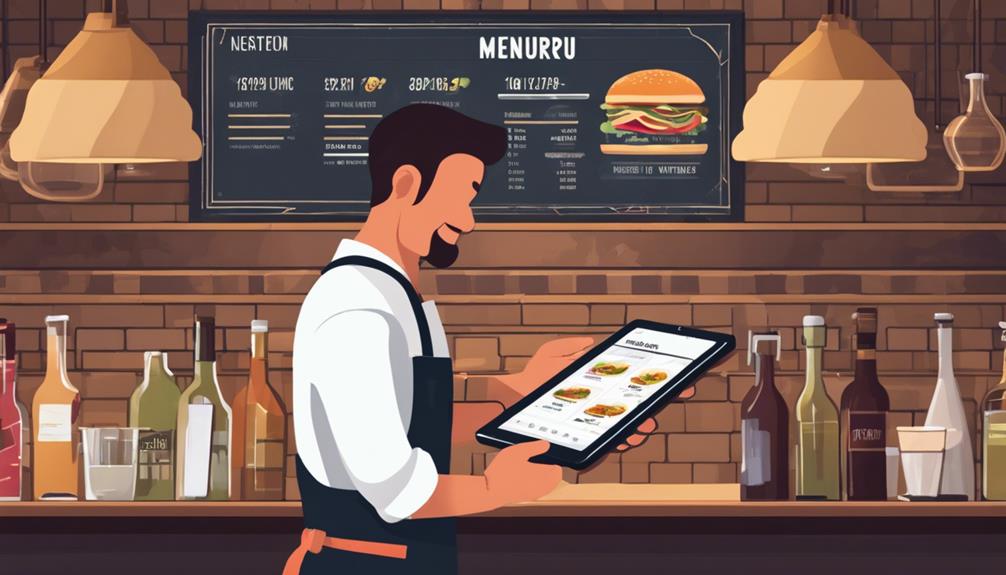Enhance your restaurant's success with data enhancement. Use analytics for personalized marketing and cost savings. Analyze customer preferences to boost loyalty. Customize menus with data insights for efficient inventory management. Real-time updates and accurate pricing guarantee customer satisfaction. Optimize operations for smoother service and increased revenue. Explore how data can predict trends, reduce waste, and engage eco-conscious consumers for long-term benefits. Discover the power of predictive analytics in anticipating demand and driving profitability. Stay ahead by embracing cutting-edge technologies and harnessing data-driven insights. Improve your restaurant's performance through strategic data utilization.
Key Takeaways
- Utilize data analytics for cost savings and personalized marketing.
- Analyze customer preferences for targeted marketing campaigns.
- Customize menus to reduce food waste and optimize inventory.
- Enhance operational efficiency and customer satisfaction.
- Implement real-time menu updates for accuracy and responsiveness.
Benefits of Restaurant Data Enhancement

Improving restaurant data can greatly enhance operational efficiency and customer satisfaction. By utilizing data analytics, restaurants can uncover valuable insights that lead to cost savings and improved personalized marketing strategies.
Analyzing customer preferences and behavior through data can enable targeted marketing campaigns, ultimately increasing customer engagement and loyalty.
Moreover, menu customization based on data analysis allows restaurants to tailor offerings to match customer preferences accurately. This leads to reduced food waste and optimized inventory management, resulting in significant cost savings.
Real-time Menu Updates
Enhancing your restaurant's data can facilitate real-time menu updates, ensuring accuracy and responsiveness to customer preferences and market trends. By integrating inventory management into your data enhancement strategy, you can automatically update your menu based on ingredient availability. This real-time adjustment helps prevent customer disappointment due to out-of-stock items and enhances operational efficiency.
Moreover, strong supplier relationships play an essential role in ensuring real-time menu updates. By maintaining close connections with your suppliers and updating your data accordingly, you can quickly reflect any changes in ingredient prices or availability on your menu. This proactive approach not only keeps your menu accurate but also helps in managing costs effectively.
Incorporating inventory management and nurturing supplier relationships within your data enhancement efforts enables your restaurant to stay agile and competitive. Embracing real-time menu updates through enhanced data processes empowers you to cater to customer demands promptly and adapt to market dynamics efficiently.
Improved Pricing Accuracy

To guarantee precise pricing accuracy for your restaurant, meticulous data management and regular market analysis are essential. Menu optimization and cost analysis play a vital role in making sure that your prices align with your expenses and customer expectations.
By constantly evaluating the cost of ingredients and analyzing menu performance, you can make informed decisions about pricing adjustments.
Utilizing advanced inventory tracking systems allows you to monitor ingredient costs in real-time, enabling you to adjust menu prices accordingly. This proactive approach ensures that your pricing remains competitive while also maintaining profitability.
Additionally, incorporating revenue forecasting techniques assists in predicting future sales trends, allowing you to adjust prices preemptively based on anticipated demand.
Enhanced Customer Experience
Creating memorable dining experiences hinges on understanding and catering to customer preferences and needs. By leveraging data analytics, restaurants can enhance customer engagement and satisfaction through personalized recommendations. Through analyzing past orders, dining habits, and feedback, establishments can gain valuable insights into individual preferences, allowing for tailored dining experiences.
Utilizing data analytics enables restaurants to anticipate customer needs and provide proactive suggestions, enhancing the overall dining experience. By recommending dishes based on past orders or suggesting wine pairings that complement a customer's favorite meal, establishments can create personalized interactions that leave a lasting impression.
Furthermore, data-driven customer engagement strategies help in building stronger relationships with patrons. By understanding their preferences and consistently delivering exceptional service, restaurants can foster loyalty and drive repeat business. Ultimately, by harnessing the power of data analytics to provide personalized recommendations, restaurants can elevate customer satisfaction levels and differentiate themselves in a competitive market.
Streamlined Data Management

By centralizing and optimizing data collection and storage processes, you can effectively streamline data management within your restaurant operations. Efficient operations rely heavily on how well you manage your data. By having a centralized system in place, you can easily access and analyze customer information, order histories, and preferences. This allows you to make data-driven decisions quickly and accurately, leading to smoother operations and improved customer experiences.
Streamlined data management not only enhances operational efficiency but also fosters customer loyalty. When you can efficiently track and utilize customer data, you can tailor your services to meet their needs and preferences effectively. Personalized experiences based on data insights can significantly enhance customer satisfaction and loyalty.
Additionally, streamlined data management enables you to resolve issues promptly, anticipate customer demands, and provide a seamless dining experience.
Increased Operational Efficiency
Improve your restaurant's efficiency through data-driven operational enhancements. By utilizing advanced data analytics, you can optimize inventory management and labor scheduling, making sure that you have the right amount of ingredients and staff at the right times.
Efficient inventory management leads to reduced food waste, cutting down on unnecessary costs and improving overall profitability.
Moreover, with precise data analysis, you can streamline labor scheduling, aligning employee shifts to peak hours of operation, thereby enhancing productivity and customer service. This strategic approach not only minimizes labor costs but also ensures that your staff is effectively utilized, contributing to a smoother workflow and enhanced customer satisfaction.
Additionally, data-driven insights can help enhance the speed of service in your restaurant. By analyzing customer traffic patterns and order processing times, you can identify bottlenecks and optimize workflows to deliver quicker and more efficient service.
This not only improves customer experience but also boosts table turnover rates, leading to increased revenue opportunities.
Competitive Edge With Data Optimization

Enhance your restaurant's competitive edge by leveraging data optimization strategies to outperform your competitors. By utilizing data analytics, you can gain valuable customer insights and stay ahead of market trends. One key aspect where data optimization can greatly boost your competitive edge is through menu personalization. Understanding your customers' preferences and behaviors through data analytics allows you to tailor your menu offerings to their specific tastes, enhancing their overall dining experience and increasing customer loyalty.
To illustrate the benefits of data optimization further, consider the following table showcasing the impact it can have on your restaurant's competitive edge:
| Data Optimization Benefits | ||
|---|---|---|
| Enhanced Customer Insights | Improved Menu Personalization | Competitive Market Analysis |
| Tailored Marketing Strategies | Streamlined Operations | Increased Customer Engagement |
| Real-time Decision Making | Targeted Promotions | Market Expansion Opportunities |
Future Trends in Data Enhancement
Explore upcoming advancements in data enhancement to stay at the forefront of technological innovation in the restaurant industry. Data-driven personalization and AI integration are set to revolutionize customer experiences. By leveraging customer data, restaurants can tailor offerings to individual preferences, enhancing satisfaction and loyalty.
Integrating AI into operations can streamline processes, optimize resource allocation, and even predict customer behavior.
Sustainability is another key trend in data enhancement for restaurants. Utilizing data to track and reduce food waste, manage energy consumption, and source ingredients responsibly not only benefits the environment but also resonates with increasingly eco-conscious consumers.
Predictive analytics will play an essential role in anticipating trends, optimizing inventory management, and forecasting demand, allowing restaurants to operate more efficiently and profitably.
To remain competitive in the evolving landscape of the restaurant industry, embracing these future trends in data enhancement is vital. Stay ahead by harnessing the power of data-driven insights and cutting-edge technologies to drive success in your establishment.
Conclusion
To sum up, enhancing your restaurant data can bring numerous benefits, from real-time menu updates to improved pricing accuracy. By investing in data optimization, you can streamline operations, enhance customer experience, and gain a competitive edge in the industry.
Stay ahead of the curve by embracing the future trends in data enhancement and watch your restaurant thrive in the digital age.




